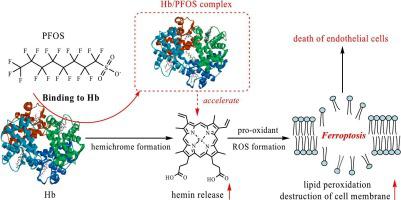International Journal of Biological Macromolecules ( IF 7.7 ) Pub Date : 2023-11-13 , DOI: 10.1016/j.ijbiomac.2023.128069 Ya-Di Yang 1 , Naihao Lu 1 , Rong Tian 1

|
Perfluorooctane sulfonate (PFOS), a representative of perfluorinated compounds in industrial and commercial products, has posed a great threat to animals and humans via environmental exposure and dietary consumption. Herein, we investigated the effects of PFOS binding on the redox state and stability of two hemoproteins (hemoglobin (Hb) and myoglobin (Mb)). Fluorescence spectroscopy, circular dichroism and UV–vis absorption spectroscopy demonstrated that PFOS could induce the conformational changes of proteins along with the exposure of heme cavity and generation of hemichrome, which resulted in the increased release of free hemin. After that, free hemin liberated from hemoproteins led to reactive oxygen species formation, lipid peroxidation, cell membrane damage and loss of cell viability in vascular endothelial cells, while neither Hb nor Mb did show cytotoxicity. Chemical inhibitors of ferroptosis effectively mitigated hemin-caused toxicity, identifying the hemin-dependent ferroptotic cell death mechanisms. These data demonstrated that PFOS posed a potential threat of toxicity through a mechanism which involved its binding to hemoproteins, decreased oxygen transporting capacity, and increased hemin release. Altogether, our findings elucidate the binding mechanisms of PFOS with two hemoproteins, as well as possible risks on vascular endothelial cells, which would have important implications for the human and environmental toxicity of PFOS.
中文翻译:

全氟辛烷磺酸与血红素蛋白的相互作用及其与分子毒理学的相关性
全氟辛烷磺酸(PFOS)是工业和商业产品中全氟化合物的代表,通过环境暴露和饮食消费对动物和人类造成巨大威胁。在此,我们研究了 PFOS 结合对两种血红蛋白(血红蛋白 (Hb) 和肌红蛋白 (Mb))氧化还原状态和稳定性的影响。荧光光谱、圆二色性和紫外可见吸收光谱表明,PFOS可引起蛋白质构象变化,暴露血红素空腔并产生半色素,从而导致游离血红素释放增加。此后,从血红素蛋白中释放出的游离血红素导致血管内皮细胞中活性氧的形成、脂质过氧化、细胞膜损伤和细胞活力丧失,而Hb和Mb均未表现出细胞毒性。铁死亡的化学抑制剂有效减轻了血红素引起的毒性,确定了血红素依赖性铁死亡细胞死亡机制。这些数据表明,全氟辛烷磺酸通过与血红素蛋白结合、降低氧运输能力和增加氯高铁血红素释放的机制构成潜在的毒性威胁。总而言之,我们的研究结果阐明了 PFOS 与两种血红素蛋白的结合机制,以及对血管内皮细胞可能存在的风险,这将对 PFOS 的人类和环境毒性产生重要影响。






























 京公网安备 11010802027423号
京公网安备 11010802027423号